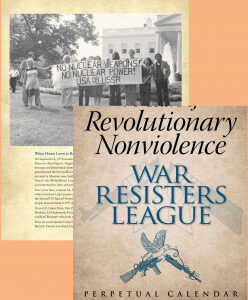The Early Years: The Feminist Leadership of WRL
 In founding and then leading WRL for nearly 20 years, Jessie Wallace Hughan was supported by an impressive group of women, many having previously headed other women’s pacifist, suffragist, anti-conscription, and socialist organizations. Unusually independent for their time, most had graduated from prestigious universities, supported themselves with careers, and were engaged in romantic relationships with like-minded women. Among these colleagues of Jessie were her sister Evelyn, with whom she lived; and Elinor Byrnes and Olivia Torrence, both veterans of women’s peace organizations who became members of WRL’s first executive committee.
In founding and then leading WRL for nearly 20 years, Jessie Wallace Hughan was supported by an impressive group of women, many having previously headed other women’s pacifist, suffragist, anti-conscription, and socialist organizations. Unusually independent for their time, most had graduated from prestigious universities, supported themselves with careers, and were engaged in romantic relationships with like-minded women. Among these colleagues of Jessie were her sister Evelyn, with whom she lived; and Elinor Byrnes and Olivia Torrence, both veterans of women’s peace organizations who became members of WRL’s first executive committee.
Most notable among Jessie’s circle of friends were Tracy D. Mygatt (1885-1973) and Frances Witherspoon (1887-1973) who became early WRL organizers. By 1915 they had already co-founded the Anti-Enlistment League together and become involved in the Women’s International League for Peace and Freedom (WILPF), founded by Jane Addams and Carrie Chapman. If a great love story is part of WRL’s history, it is Tracy and Frances’. Their devotion to each other lasted from their undergraduate days at Bryn Mawr College until their deaths in a Philadelphia nursing home, just three months apart. I was extraordinarily privileged to correspond with Tracy and Frances in the early 1970s while I was a staff member of WRL, as they continued to be engaged with WRL and eager to hear about our anti-Vietnam war activities.
In addition, women involved in other the peace and justice organizations, such as WILPF’s Mildred Scott Olmstead and Orlie Pell, had peripheral relationships with Jessie and WRL largely through international peace conferences that were women-centric in the early twentieth century. Significant among them was Eleanor Roosevelt. Inclined naturally toward pacifism, though not unilateral disarmament, she worked with and supported WRL as well as the American Friends Service Committee and the Fellowship of Reconciliation.
The domination of women in WRL was not to last beyond the 1930s. Although Jessie remained involved in women’s peace organizations, she believed in the importance of mixed-gender organizations and, in fact, thought that pacifism could best be promoted by organizations led by men. During World War II, when WRL limited its public activism, women’s role consisted of providing one-on-one support to men in prison or civilian public service camps for refusing to fight. For example, Igal Roodenko’s sister Vivian offered guidance as her brother decided to leave a camp and instead serve a prison sentence. Women also staffed the office along with men not eligible for the draft, but relinquished their positions when resisters returned home.
By the end of World War II men had assumed leadership in WRL and retained control for over 30 years.
– Blog post by Wendy Schwartz
Sources: Scott Bennett, Radical Pacifism: The War Resisters League and Gandhian Nonviolence in America, 1915-1963; Lillian Faderman, To Believe in Women; Blanche Wiesen Cook, Eleanor Roosevelt, Volume 3: The War Years and After, 1939-1962
Top Photo: Eddie Gottlieb and Frances Witherspoon (standing), then Ida Kaufman, Tracy Mygatt, Marion Gottlieb below them, with Raquel Kaufman, Jesse Kaufman, and baby Toby Gottlieb at the bottom. Courtesy of Raquel (Kaufman) Wood
Share



 WRL Perpetual Calendar
WRL Perpetual Calendar